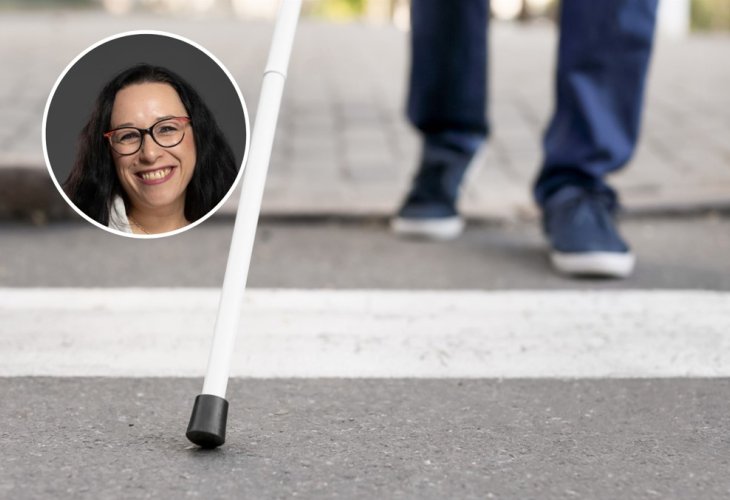"This Is How We Established a Walking Trail for the Blind"
Bella Nudelman, an architect at KKL Central District, reveals how Israel's only forest walking trail for the blind was established, allowing them to navigate and even ride bicycles.
 Background: shutterstock, Inset: Architect Bella Nudelman. Photo: Haim Versano, KKL Photo Archive
Background: shutterstock, Inset: Architect Bella Nudelman. Photo: Haim Versano, KKL Photo ArchiveThe summer days are already here, and among the various trips and sites to explore, there is a uniquely special site - the 'Park for the Blind' built by KKL in the Ben Shemen forest.
The park, as its name suggests, is intended for the blind and visually impaired and is specifically built for them, with a path bordered throughout its length by curb stones, allowing those who walk there to navigate safely. There is also a metal pipe railing along the entire path, and accessible signage with text in Braille alongside regular print. KKL has also developed a voice navigation system, allowing smartphone users to listen to audio explanations at nine listening stations along the path.
For those still wondering how the blind can orient themselves in such a park, and where the original idea for such a unique park in Israel came from, we reached out to hear the fascinating explanation from Bella Nudelman, an architect at KKL Central District and responsible for bicycle planning and accessibility.
"The Blind Also Want to Hike"
"KKL forests in central Israel serve a very large population," Bella opens and explains. "People come from all over the Jerusalem area and also from Ramla-Lod and the surrounding area. As a result, the place is very developed, with many bicycle trails, picnic areas, walking trails, monuments, and overall, these are the most active forests in Israel. Within these forests, there are areas we defined as visitor sites, and we also develop and adapt them for the public."
Bella clarifies that one of KKL's leading principles is to make the forests accessible to the entire public, including those with various disabilities. "Of course, we make sure to make every trail accessible according to the accessibility law," she clarifies, "but when we created the 'Trail for the Blind' the intention was to create something that had never been seen in any of the forests before - a route that is not only accessible but also fully adapted for people who cannot see."
According to Bella, the trail was first established in the 2000s, with original planning done in collaboration with the 'Action' association, which accompanies the blind. The association advised and assisted in everything necessary so that the blind could safely walk the path, and also feel the way and the scenery. "That's why, in addition to the railing and the unique shape of the path, we ensured that there would also be aromatic herbs along the path that could be touched, felt, and smelled. The signage is also in 3D for visualization and feeling," she details.
Although the path has existed for years, Bella notes that over time the project was neglected and forgotten until it reached a state of severe neglect. "But about three years ago, we decided no more," she recalls. "At that time, we initiated the renewal of the project, with a team of individuals dedicated to the park's revival, with a genuine desire to strengthen the connection with the blind community which is so important and dear to us. We all dedicated many efforts to this, adapting the path to new accessibility standards, renewing paths, planting trees, and investing in planning and execution."
Bella emphasizes that throughout the process, they relied on the architectural planning of the 'Action' association and worked alongside an accessibility expert specialized in blindness, and primarily brought blind persons to the site to let them experience and contribute their opinions.
And indeed, are those who currently visit the trail exclusively blind individuals?
"The park is open to the entire public," Bella clarifies, "but almost at any given hour you will see blind individuals, sometimes navigating alone, sometimes with guide dogs, and sometimes even on specially designed bicycles, as this is also possible on this park's trails. "Personally," she adds, "what particularly moves me is to see people who come to the park and simply tie a scarf over their eyes, intending to finally experience what blind people go through. In such situations, it often happens that the blind hold the hands of the 'sighted' and help them navigate. These are especially moving scenes."

